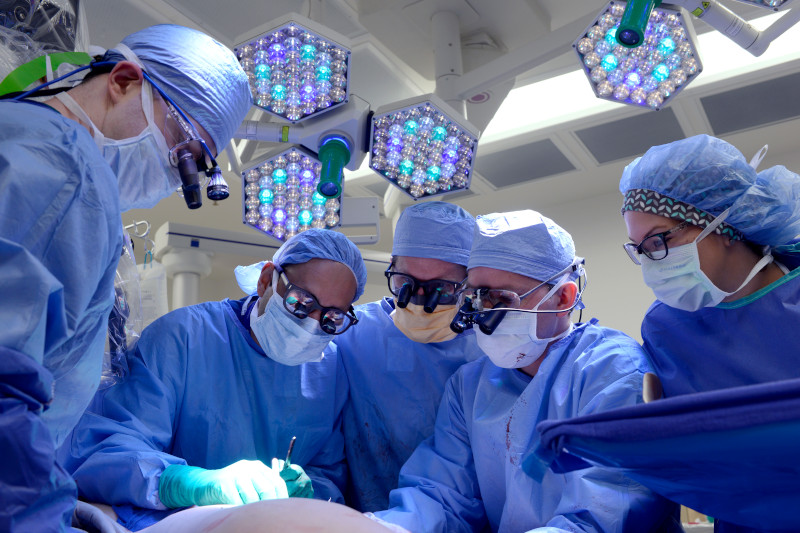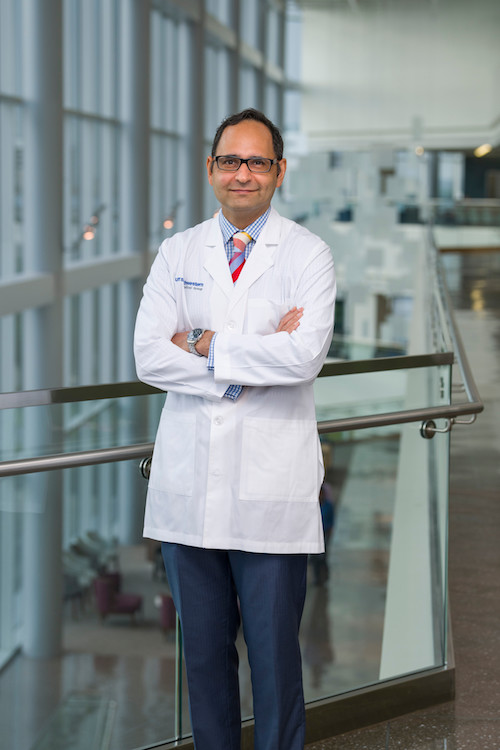Building a better breast

DALLAS – Feb. 4, 2020 – Surgeons at UT Southwestern Medical Center have developed a process to determine the best approach for single breast reconstruction that involves mapping out prior to surgery which blood vessels to use in lower abdominal tissue to minimize the chances of complications or undesirable outcomes including partial tissue death known as fat necrosis, which can cause local pain and lumpiness. The results were published last month in the Journal of Reconstructive Microsurgery.
At UT Southwestern, before surgery patients routinely undergo computed tomographic angiography (CTA), a procedure that maps out where major blood vessels run in the abdomen. Typically, breast reconstructive surgeons use CTA to decide prior to surgery which blood vessels to use and assess the quality and caliber of the vessels. The UT Southwestern team uses these CTA maps to preplan both the blood vessels and the overall design of the pedicle flap that ultimately translates into shaping a breast that the patient will be happy with.

“Now we use the CTA results to have a conversation with the patient in clinic,” says Sumeet S. Teotia, M.D., an associate professor of plastic surgery at UT Southwestern Medical Center and director of the breast-reconstruction program at UT Southwestern’s Harold C. Simmons Comprehensive Cancer Center. “Reviewing the scans helps the patient see what we may encounter in surgery and gives them confidence going into the procedure. Potentially, we can reduce and even avoid long-term complications.”
According to the experts, single breast reconstruction using one’s own abdominal tissue can be particularly challenging in trying to match the existing breast in size and shape. This becomes more challenging in patients who do not have enough tissue in their abdomen for reconstruction, those whose intact breast is large or sags, or patients who have large abdominal scars. But mapping out which blood vessels need to be cut and reconnected and how to approach cutting the abdominal flap might be the trickiest part.
The team reviewed surgical approaches and results from patients at UT Southwestern who underwent so-called free flap breast reconstruction procedures from 2009-2017 and identified 512 patients, 150 of whom were included in this study. The mean age of this patient group was 57 and mean BMI was 27. Seventy-five patients underwent bilateral, single flap reconstruction and 75 underwent conjoined, stacked double-pedicle flap reconstruction. Most of these patients, 81 percent, underwent delayed reconstruction. The team found that the patients who underwent conjoined stacked double-pedicle flap reconstruction involved fewer blood vessels but also experienced less fat necrosis, 2.7 percent versus 14.4 percent in single flap reconstruction.
“The CTA scan allows us to visuospatially create a model of the breast in advance so we can be faster in the operating room. The surgeons still visually confirm the scan results during surgery, assuring a high degree of reliability,” Teotia explains. “Our algorithm allows us to be anatomically strategic in choosing the best blood supply for that particular tissue; it is important to have optimal blood supply for the best results, which ultimately translates into an improved outcome and breast shape.”
Other authors on the paper include Min-Jeong Cho, M.D. and Nicholas Haddock, M.D., both of UT Southwestern.
This study did not receive any outside funding.
The authors declare no conflicts of interest.
About UT Southwestern Medical Center
UT Southwestern, one of the premier academic medical centers in the nation, integrates pioneering biomedical research with exceptional clinical care and education. The institution’s faculty has received six Nobel Prizes, and includes 22 members of the National Academy of Sciences, 17 members of the National Academy of Medicine, and 14 Howard Hughes Medical Institute Investigators. The full-time faculty of more than 2,500 is responsible for groundbreaking medical advances and is committed to translating science-driven research quickly to new clinical treatments. UT Southwestern physicians provide care in about 80 specialties to more than 105,000 hospitalized patients, nearly 370,000 emergency room cases, and oversee approximately 3 million outpatient visits a year.
